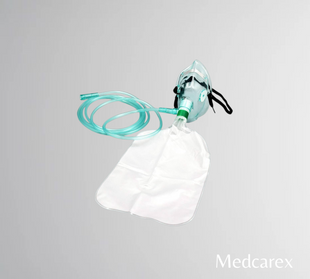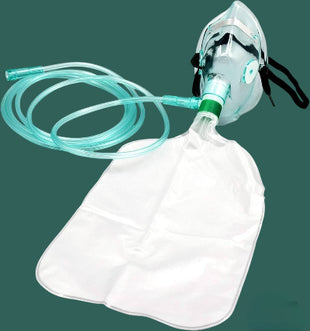Sort + Filter
Oxygen Tubing masks and cannulas
Oxygen cannulas and masks are both devices used to deliver supplemental oxygen, but they differ in design, comfort, and how much oxygen they can provide. Here's a quick comparison to help you understand when each is used:
Nasal Cannulas
-
Design: Soft tubing with two small prongs that sit in the nostrils.
-
Flow Rate: Typically 1–6 liters per minute (L/min).
-
FiO₂ (oxygen concentration): Around 24–40%.
-
Best For: Mild to moderate oxygen needs, long-term use, and patients who need to eat, talk, or move around comfortably.
-
Pros: Comfortable, allows mobility and communication.
-
Cons: Can dry out nasal passages at higher flows.
Simple Face Masks
-
Design: Covers the nose and mouth with an elastic strap around the head.
-
Flow Rate: 5–10 L/min.
-
FiO₂: About 30–50%.
-
Best For: Short-term use when higher oxygen levels are needed than a cannula can provide.
-
Pros: Easy to use, higher oxygen delivery.
-
Cons: Can feel claustrophobic, interferes with eating and speaking.
Venturi Masks
-
Design: Face mask with color-coded valves to control oxygen concentration precisely.
-
Flow Rate: Varies by valve (e.g., 4–15 L/min).
-
FiO₂: Fixed levels (e.g., 24%, 28%, 35%, etc.).
-
Best For: Patients with COPD or when precise oxygen delivery is critical.
-
Pros: Accurate oxygen delivery.
-
Cons: Bulky, less comfortable.
Non-Rebreather Masks
-
Design: Face mask with a reservoir bag and one-way valves.
-
Flow Rate: 10–15 L/min.
-
FiO₂: Up to 90–100%.
-
Best For: Emergency situations or severe hypoxia.
-
Pros: Delivers high oxygen concentration quickly.
-
Cons: Not for long-term use, must fit snugly.
Each device has its place depending on the patient’s condition and oxygen needs. Want help choosing the right one for a specific scenario or comparing them visually? I can walk you through that too.

